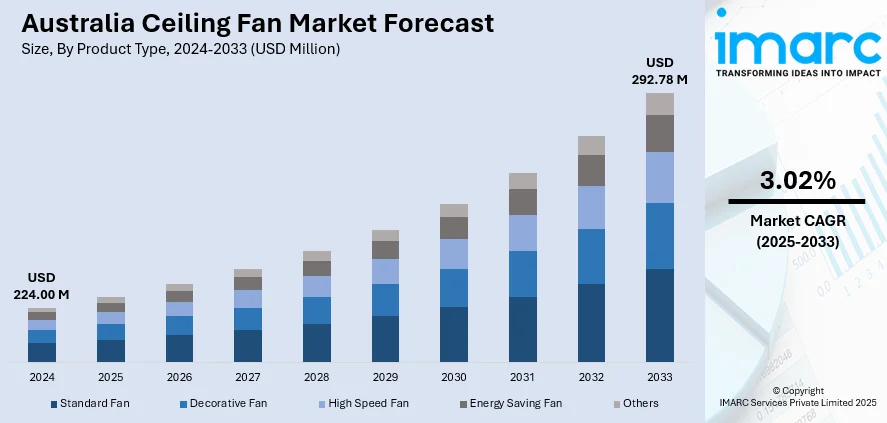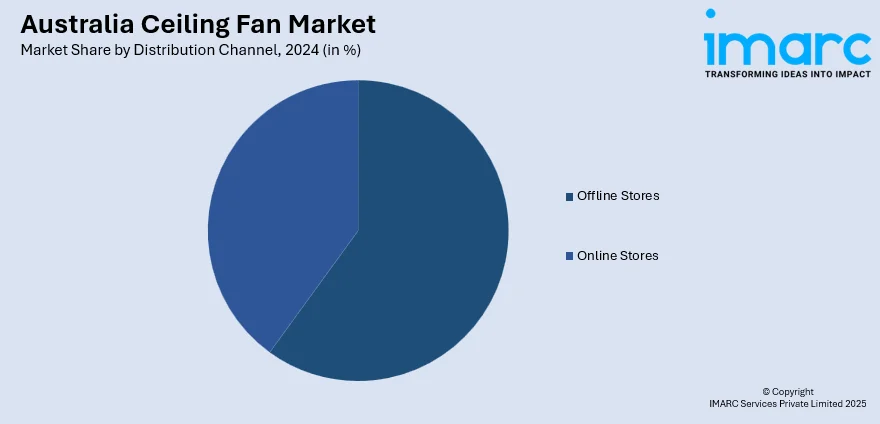
Australia Ceiling Fan Market Size, Share, Trends and Forecast by Product Type, Fan Size, Distribution Channel, End Use, and Region, 2025-2033
Australia Ceiling Fan Market Overview:
The Australia ceiling fan market size reached USD 224.00 Million in 2024. Looking forward, IMARC Group expects the market to reach USD 292.78 Million by 2033, exhibiting a growth rate (CAGR) of 3.02% during 2025-2033. The market is driven by the increasing need for energy-efficient cooling solutions. The market is driven by the rising demand for energy-efficient cooling solutions, as energy costs increase and environmental awareness grows. Ceiling fans offer a sustainable, cost-effective alternative to air conditioning, efficiently cooling homes while promoting eco-friendly living.
|
Report Attribute
|
Key Statistics
|
|---|---|
|
Base Year
|
2024
|
|
Forecast Years
|
2025-2033
|
|
Historical Years
|
2019-2024
|
| Market Size in 2024 | USD 224.00 Million |
| Market Forecast in 2033 | USD 292.78 Million |
| Market Growth Rate 2025-2033 | 3.02% |
Australia Ceiling Fan Market Trends:
Integration of Smart Technology
The emergence of smart home technology is revolutionizing the Australia ceiling fan market outlook. Customers are now increasingly choosing fans that come equipped with sophisticated features such as mobile app-based remote control, voice control, and smart home platform compatibility such as Amazon Alexa or Google Home. Smart fans enable users to adjust the fan speed, schedule usage, and even track energy consumption remotely. The ease of use and convenience of smart ceiling fans are attractive to tech-savvy consumers who appreciate ease of use and personalization. The fans' functions, which include automated modifications based on humidity and room temperature, also contribute to better energy management and more comfort in the house.

To get more information on this market, Request Sample
Energy Efficiency and Sustainable Living
As people in Australia grow more eco-aware, energy efficiency has been an important factor when choosing cooling options. Ceiling fans are being preferred more and more due to their low energy usage, with the usual amount being between 15 to 90 watts per hour, whereas air conditioners (Acs) can use anywhere from 1,500 to 5,000 watts per hour. Such a high variation in power usage makes ceiling fans a budget-friendly option, especially for areas with more moderate climates. Not only do these fans assist homeowners in saving electricity bills, but they also help in minimizing their carbon footprint. As consumers demand more, manufacturers are launching more energy-efficient products with new motor technologies, better airflow dynamics, and energy-saving capabilities further resulting in the increase in Australia ceiling fan market share. This follows Australia's overall objective of sustainability as customers increasingly demand environment-friendly products that minimize greenhouse gas (GHG) emissions and save natural resources.
Aesthetic Appeal and Customization
Consumers in Australia increasingly value the style of ceiling fans, perceiving them not simply as useful devices but as design elements of particular importance to their interior space. This reflects an overall trend toward home decoration wherein aesthetic balance and individuality matter as much or more than use. With so many colors, materials, and styles to choose from, consumers are choosing fans that fit their décor style whether that's modern minimalism, coastal chic, or vintage country charm. To meet this demand, manufacturers are introducing customizable products, enabling buyers to customize fan finishes, blade styles, and lighting features to suit their interiors. This fusion of function and form has made ceiling fans fashionable, statement-making features of Australian homes, contributing to both comfort and design harmony.
Australia Ceiling Fan Market Segmentation:
IMARC Group provides an analysis of the key trends in each segment of the market, along with forecasts at the region level for 2025-2033. Our report has categorized the market based on product type, fan size, distribution channel, and end use.
Product Type Insights:
- Standard Fan
- Decorative Fan
- High Speed Fan
- Energy Saving Fan
- Others
The report has provided a detailed breakup and analysis of the market based on the product type. This includes standard fan, decorative fan, high speed fan, energy saving fan, and others.
Fan Size Insights:
- Small
- Medium
- Large
A detailed breakup and analysis of the market based on the fan size have also been provided in the report. This includes small, medium, and large.
Distribution Channel Insights:

- Offline Stores
- Online Stores
The report has provided a detailed breakup and analysis of the market based on the distribution channel. This includes offline stores and online stores.
End Use Insights:
- Residential
- Commercial
- Industrial
A detailed breakup and analysis of the market based on the end use have also been provided in the report. This includes residential, commercial, and industrial.
Regional Insights:
- Australia Capital Territory & New South Wales
- Victoria & Tasmania
- Queensland
- Northern Territory & Southern Australia
- Western Australia
The report has also provided a comprehensive analysis of all the major regional markets, which include Australia Capital Territory & New South Wales, Victoria & Tasmania, Queensland, Northern Territory & Southern Australia, and Western Australia.
Competitive Landscape:
The market research report has also provided a comprehensive analysis of the competitive landscape. Competitive analysis such as market structure, key player positioning, top winning strategies, competitive dashboard, and company evaluation quadrant has been covered in the report. Also, detailed profiles of all major companies have been provided.
Australia Ceiling Fan Market News:
- In April 2024: Martec introduced the Elite DC Ceiling Fan, featuring WiFi connectivity, six speed settings, and an adjustable LED light. Its sleek design caters to both indoor and outdoor spaces, offering improved functionality and modern appeal.
- In April 2024: In April 2024, Modern Forms unveiled several smart ceiling fan trends, including the Aura model with eight blades and integrated LED lighting, the large-scale Size Matters fan with dimmable LEDs, the industrial Spinster fan with aerodynamic blades, and the Veloce fandelier, all featuring energy-efficient DC motors and smart home compatibility.
Australia Ceiling Fan Market Report Coverage:
| Report Features | Details |
|---|---|
| Base Year of the Analysis | 2024 |
| Historical Period | 2019-2024 |
| Forecast Period | 2025-2033 |
| Units | Million USD |
| Scope of the Report |
Exploration of Historical Trends and Market Outlook, Industry Catalysts and Challenges, Segment-Wise Historical and Future Market Assessment:
|
| Product Types Covered | Standard Fan, Decorative Fan, High Speed Fan, Energy Saving Fan, Others |
| Fan Sizes Covered | Small, Medium, Large |
| Distribution Channels Covered | Offline Stores, Online Stores |
| End Uses Covered | Residential, Commercial, Industrial |
| Regions Covered | Australia Capital Territory & New South Wales, Victoria & Tasmania, Queensland, Northern Territory & Southern Australia, Western Australia |
| Customization Scope | 10% Free Customization |
| Post-Sale Analyst Support | 10-12 Weeks |
| Delivery Format | PDF and Excel through Email (We can also provide the editable version of the report in PPT/Word format on special request) |
Key Questions Answered in This Report:
- How has the Australia ceiling fan market performed so far and how will it perform in the coming years?
- What is the breakup of the Australia ceiling fan market on the basis of product type?
- What is the breakup of the Australia ceiling fan market on the basis of fan size?
- What is the breakup of the Australia ceiling fan market on the basis of distribution channel?
- What is the breakup of the Australia ceiling fan market on the basis of end use?
- What is the breakup of the Australia ceiling fan market on the basis of region?
- What are the various stages in the value chain of the Australia ceiling fan market?
- What are the key driving factors and challenges in the Australia ceiling fan?
- What is the structure of the Australia ceiling fan market and who are the key players?
- What is the degree of competition in the Australia ceiling fan market?
Key Benefits for Stakeholders:
- IMARC’s industry report offers a comprehensive quantitative analysis of various market segments, historical and current market trends, market forecasts, and dynamics of the Australia ceiling fan market from 2019-2033.
- The research report provides the latest information on the market drivers, challenges, and opportunities in the Australia ceiling fan market.
- Porter's five forces analysis assist stakeholders in assessing the impact of new entrants, competitive rivalry, supplier power, buyer power, and the threat of substitution. It helps stakeholders to analyze the level of competition within the Australia ceiling fan industry and its attractiveness.
- Competitive landscape allows stakeholders to understand their competitive environment and provides an insight into the current positions of key players in the market.
Need more help?
- Speak to our experienced analysts for insights on the current market scenarios.
- Include additional segments and countries to customize the report as per your requirement.
- Gain an unparalleled competitive advantage in your domain by understanding how to utilize the report and positively impacting your operations and revenue.
- For further assistance, please connect with our analysts.
 Request Customization
Request Customization
 Speak to an Analyst
Speak to an Analyst
 Request Brochure
Request Brochure
 Inquire Before Buying
Inquire Before Buying




.webp)




.webp)












